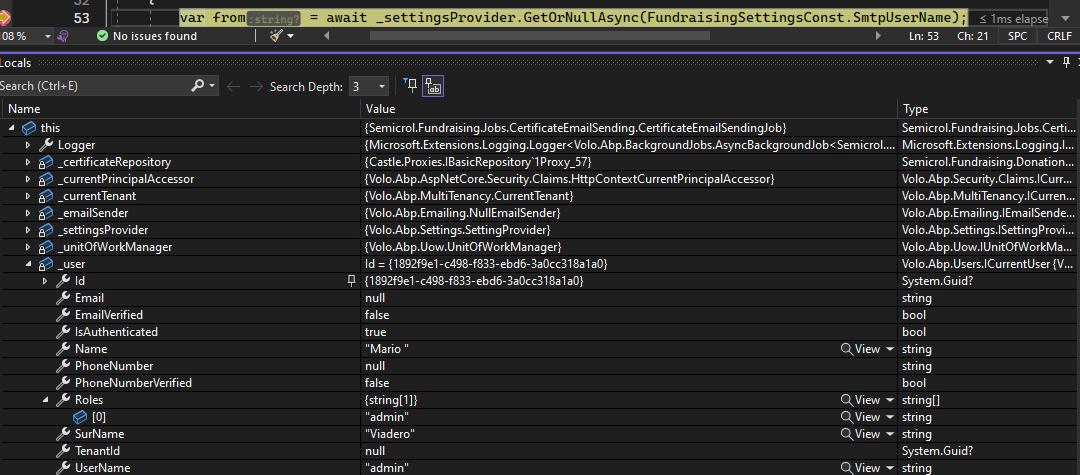أنشطة "mariovh"
Hello, It works with the handler.
Now the same issue i had to publish in multiple topics than i have to implement MyAzureDistributedEventBus:AzureDistributedEventBus, i have to implement the receiver/consumer part with inbox pattern, where i need to add to inbox and process messages comming from multiple queues on Azure Service Bus. Is that possible?
Thank you
Hello, It works with google protobuf instead of EntityEto replacing it on the Mapping.
Following the documentation example using Etos:
Configure<AbpDistributedEntityEventOptions>(options =>
{
options.AutoEventSelectors.Add<Product>();
options.EtoMappings.Add<Product, ProductEto>();
});
Adds a selector to allow to publish the create, update and delete events for the Product entity.'
Is possible for create and update events map to ProductEto, and for delete events mapping to other Eto, for example DeletedProductEto? Is there a way to configure the module with this aproach?
Thank you for your help.
Hello,
I have two more questions, Im reviewing class DistributedEventBusBase.cs method protected virtual async Task<bool> AddToOutboxAsync(Type eventType, object eventData) and i cant insert to AbpEventOutbox table values on ExtraProperties column when overriding the method.
My second question, Im working with google protobuff to publish binary messages on Azure Service Bus, using MyAzureDistributedEventBus from previous questions, and casting Etos to proto generated classes before publishing on Azure Service Bus. I dont know if it is possible to instead of working on distributed events with Etos and IEntityEto<TKey> interface, is possible to work with a custom interface or a IMessage interface from google protobuff protocol.
Thanks
Hello,
What I mean is whether applications by default can only publish to one topic. So, for two applications to communicate through Azure Service Bus, would they both publish and consume all their events from all their aggregates in the same topic? And what I mean is about the structure of Topics, Subscriptions, and Queues in Azure for the communication of both applications.
Then, regarding multitenancy, I have a question. If I have Application 1 with tenants A and B, and Application 2 with tenants A and B, and the messages published in Azure Service Bus comply with the interfaces you mentioned (IMultitenant or IEventDataMayHaveTenantId), how does Application 2 know which tenant a message published by Application 1 belongs to if the internal IDs of their Tenants in their SaasTenants tables are different in both applications?
Thanks, and sorry for the confusion.
Hello, works fine but i have doubts about it, following your approach of publishing in a single topic for all events generated by all aggregates. For a second application also using Abp, multitenancy, and the outbox and inbox patterns, which wants to integrate with the first application through Azure Service Bus and consume messages from a certain type of aggregate or event. How is the topology managed in Azure? How does the second application know which of its tenants each message published by the first application corresponds to? What is the standard way that Abp has to communicate applications with Service Bus and the outbox and inbox patterns?
Thanks
I will try to implement a custom AzureDistributedEventBus following your code.
Thank you
hello,
i tried this
ObjectHelper.TrySetProperty(certificateRecord, x => x.CreatorId, () => YourId);
await _certificateRepository.InsertAsync(certificateRecord);
And it works fine.
Thank you!
hi, yes sure, basically sends an email and then inserts a domain entity and marks as processed, or sending email error if there's an error.
public class CertificateEmailSendingJob : AsyncBackgroundJob<CertificateEmailSendingArgs>, ITransientDependency
{
private readonly IEmailSender _emailSender;
private readonly ISettingProvider _settingsProvider;
private readonly ICurrentTenant _currentTenant;
private readonly IDonationCertificateRepository _certificateRepository;
private readonly IUnitOfWorkManager _unitOfWorkManager;
private readonly ICurrentPrincipalAccessor _currentPrincipalAccessor;
public CertificateEmailSendingJob(IEmailSender emailSender,
ISettingProvider settingsProvider,
ICurrentTenant currentTenant,
IDonationCertificateRepository certificateRepository,
IUnitOfWorkManager unitOfWorkManager,
ICurrentPrincipalAccessor currentPrincipalAccessor)
{
_emailSender = emailSender;
_settingsProvider = settingsProvider;
_currentTenant = currentTenant;
_certificateRepository = certificateRepository;
_unitOfWorkManager = unitOfWorkManager;
_currentPrincipalAccessor = currentPrincipalAccessor;
}
public override async Task ExecuteAsync(CertificateEmailSendingArgs args)
{
var claims = JobsExtensions.GetUserAsync(args.User.Id, args.User.Name, args.User.Surname, args.User.UserName, args.User.Roles);
using (_currentPrincipalAccessor.Change(claims.claims))
{
using (_currentTenant.Change(args.TenantId))
{
var from = await _settingsProvider.GetOrNullAsync(FundraisingSettingsConst.SmtpUserName);
using var memoryStream = new MemoryStream(args.CertificateFile);
var attachment = new Attachment(memoryStream, new ContentType(MediaTypeNames.Application.Pdf))
{
ContentDisposition = { FileName = args.CertificateFileName }
};
var message = new MailMessage(
from,
args.DonorEmail,
args.EmailSubject,
args.EmailBody);
message.Attachments.Add(attachment);
using var uow = _unitOfWorkManager.Begin(
requiresNew: true, isTransactional: false);
try
{
await _emailSender.SendAsync(message);
var certificateRecord =
new DonationCertificate(Guid.NewGuid(), args.DonorId, args.LabelId,
args.EmailTemplateLabelId,
DonationCertificateStatus.Processed,
args.Year,
args.DonationId);
await _certificateRepository.InsertAsync(certificateRecord);
}
catch (Exception)
{
var certificateRecord =
new DonationCertificate(Guid.NewGuid(), args.DonorId, args.LabelId,
args.EmailTemplateLabelId,
DonationCertificateStatus.EmailSendingError,
args.Year,
args.DonationId);
await _certificateRepository.InsertAsync(certificateRecord);
}
await uow.CompleteAsync();
}
}
}
}
public static class JobsExtensions
{
public static (Guid? userId, ClaimsPrincipal claims) GetUserAsync(Guid? userId, string name, string surname, string userName, string[] roleNames)
{
var claimsList = new List<Claim>
{
new(AbpClaimTypes.UserId, userId.ToString()),
new(AbpClaimTypes.Name, name ?? "BackgroundJobUser"),
new(AbpClaimTypes.SurName, surname ?? "BackgroundJobUser"),
new(AbpClaimTypes.UserName, userName)
};
claimsList.AddRange(roleNames
.Select(_ => new Claim(AbpClaimTypes.Role, _)).ToList());
return (userId, new ClaimsPrincipal(new ClaimsIdentity(claimsList)));
}
}
public class CertificateEmailSendingArgs
{
public Guid? TenantId { get; set; }
public string DonorEmail { get; set; }
public string EmailSubject { get; set; }
public string EmailBody { get; set; }
public string CertificateFileName { get; set; }
public byte[] CertificateFile { get; set; }
public Guid DonorId { get; set; }
public Guid LabelId { get; set; }
public Guid EmailTemplateLabelId { get; set; }
public int? Year { get; set; }
public Guid? DonationId { get; set; }
public UserArgs User { get; set; }
}
internal class DonationCertificateRepository: EfCoreRepository<FundraisingDbContext, DonationCertificate, Guid>,IDonationCertificateRepository
I tried to switch order of change tenant and change user, same result, CreatorId is null. Something i should be doing wrong changing user, because values when i generate ClaimsPrincipal are correct.
Hi,
I'm switching tenant, with ICurrentTenant, _currentTenant.Change(args.TenantId) and TenantId is correctly stored. But switching user with ICurrentPrincipalAccessor _currentPrincipalAccessor.Change(claims) where claims are generated like this:
public static (Guid? userId, ClaimsPrincipal claims) GetUserAsync(Guid? userId, string name, string surname, string userName, string[] roleNames)
{
var claimsList = new List<Claim>
{
new(AbpClaimTypes.UserId, userId.ToString()),
new(AbpClaimTypes.Name, name ?? "BackgroundJobUser"),
new(AbpClaimTypes.SurName, surname ?? "BackgroundJobUser"),
new(AbpClaimTypes.UserName, userName)
};
claimsList.AddRange(roleNames
.Select(_ => new Claim(AbpClaimTypes.Role, _)).ToList());
return (userId, new ClaimsPrincipal(new ClaimsIdentity(claimsList)));
}
But CreatorId still null, what am I doing wrong?

